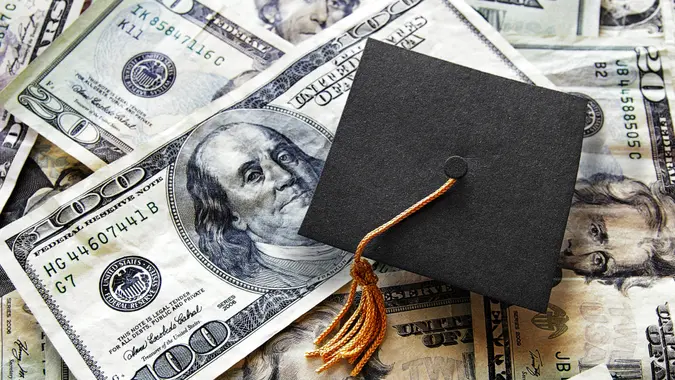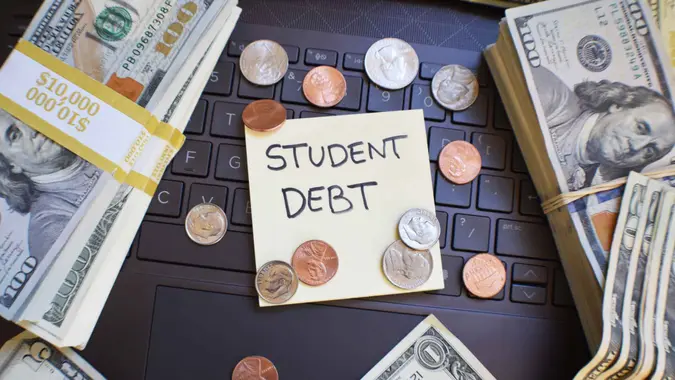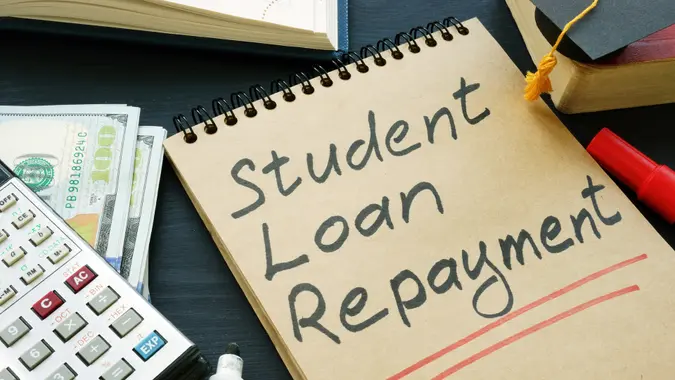What Will Student Loan Forgiveness Look Like After Trump’s Win?

Commitment to Our Readers
GOBankingRates' editorial team is committed to bringing you unbiased reviews and information. We use data-driven methodologies to evaluate financial products and services - our reviews and ratings are not influenced by advertisers. You can read more about our editorial guidelines and our products and services review methodology.

20 Years
Helping You Live Richer

Reviewed
by Experts

Trusted by
Millions of Readers
President Donald Trump has been fine-tuning his agenda for sweeping change for months. To achieve early legislative success, the new administration will be hard at work rescinding President Joe Biden’s past executive orders and issuing new ones for policy directives.
In a Nov. 12 statement, Trump vowed “to dismantle government bureaucracy, slash excess regulations, cut wasteful expenditures and restructure federal agencies” via a new “Department of Government Efficiency.” One of his main targets will be the Department of Education, whose elimination will turn student loan forgiveness on its head.
“Just about everything we know about student loan forgiveness and income-driven payment plans is likely to change under the Trump administration,” said Jay Zigmont, PhD, MBA, CFP and founder and CEO of Childfree Wealth. Here’s how that might happen.
Eliminating the Department of Education
Writing for Forbes, higher education and student loans expert Robert Farrington said that getting rid of the Department of Education is a very real possibility, as an act of Congress may be easier to accomplish with a Republican-run House and Senate.
Should that happen, loan policies and oversight could be integrated into another department’s mandate, or they could fall into the hands of state-appointed third party agencies, creating a potentially inconsistent system of student loan programs.
“Federal oversight and enforcement play a critical role,” said Northeastern University Education professor Dana Wright. “Those protections could collapse, leaving students vulnerable to unchecked discrimination.”
Changes to Current Student Loans
Regardless of the president, borrowers currently under contract to a federal loan servicer will see a shift in the types of available student loans and repayment options going forward. Those locked into contracts with providers now may see their loans transfer to another federal agency, but without any real changes, said Farrington.
As the VIN Foundation notes, income-driven repayment (IDR) plans have been offered to student loan borrowers since 1994, via various programs like the Income-Contingent Repayment (ICR) Plan and the Income-Based Repayment (IBR), the Public Service Loan Forgiveness (PSLF), the Pay As You Earn (PAYE) and the revised PAYE (REPAYE) programs.
The Saving On A Valuable Education (SAVE) Plan — the newest IDR plan, which replaced the REPAYE Plan — is currently on hold due to litigation brought by several Republican-led states claiming the plan exceeds presidential authority. If SAVE is struck down in court, the 8 million people enrolled will need to move to a different plan, possibly with higher discretionary income monthly payments.
“The SAVE program is currently in a court battle, and the new administration is unlikely to keep up the fight,” Zigmont told GOBankingRates. “During Trump’s first administration, the number of PSLF forgiveness applications approved was minuscule, and it is realistic to expect the same with the new term.
“If you were counting on the SAVE plan and forgiveness, you need to rethink your plan,” Zigmont added. “The SAVE plan prevented new interest from accruing, which is likely to disappear. You may be able to move to the IDR plan, but interest accrues, and your payment will go up.”
What You Can Do Now?
There is a good chance that Trump will pursue moving to a student loan system administered by private lending companies, who provide no time-based forgiveness or the same protections that current federal loans offer.
If you’re enjoying the payment pause afforded to SAVE IDR Plan enrollees while the program is debated in the courts, you better start saving for repayment now. Existing borrowers need to prepare to start loan payments in the near future and count on doing so for at least the next four years.
Unfortunately, future students who planned on borrowing money for tuition and fees, housing and food, books and supplies, technology and equipment, transportation and other expenses may have to make education and career compromises.
As College Rover’s Bill Townsend told Forbes, borrowing less than you want, reconsidering your field of study and potential salary and staying closer to home by enrolling in a local college or community college are things that need to be addressed when one is deciding where to apply to college and how they’re going to pay for it.
 Written by
Written by  Edited by
Edited by 























